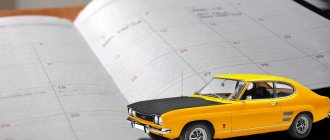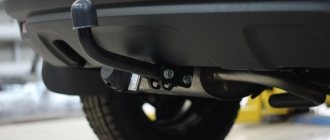Is it possible to drive on summer tires in winter?
No, this is prohibited. Such a ban is regulated by the Technical Regulations of the Customs Union in its paragraph 5.5 in its “requirements for vehicles in operation” (Appendix 8 of the regulations). At the same time, this regulatory act clearly regulates the winter and summer months. The former are December, January and February, the latter are June, July and August.
At the same time, these months may differ if any region of Russia sets its own rules, which is quite logical; and only in the direction of increase, which... is completely illogical. After all, in the same Krasnodar region, winter tires may not be required at all. But alas, such is the law!
5.5. It is prohibited to operate vehicles equipped with tires with anti-skid studs in the summer (June, July, August). It is prohibited to operate vehicles that are not equipped with winter tires that meet the requirements of paragraph 5.6.3 of this appendix during the winter period (December, January, February). Winter tires are installed on all wheels of the vehicle. The terms of the operation ban may be changed upward by regional government bodies of the member states of the Customs Union.
Thus, it is prohibited to drive on summer tires in winter - in December, January and February (dates may vary by region). It is not necessary to change to winter tires from October 1 and November 1.
Where can I find out about increasing the ban in my city?
Unfortunately, there is no way to definitively answer this question. For 2021, not a single region or city has changed the provisions of the Technical Regulations regarding summer tires in winter.
If such changes are made, this may be reflected both in local government regulations and in regional legislative acts. We regularly monitor current legislation, including in the regions, so if innovations appear regarding changing the ban on driving summer tires in the winter months, we will update this article.
You will also be interested in:
- Is there a fine for driving on summer tires in winter and winter tires in summer today? What date will it start?
- How to legally avoid a fine for a “Spikes” sign?
- Is it possible to drive on winter tires in summer and what is the fine?
Know how to bide your time
In icy conditions, the car does not listen well to the steering wheel. The front drive wheels slip when turning, and the car responds to commands with a delay. You turn the steering wheel and the car drives forward for a moment and only then smoothly responds to commands. Management becomes unclear, flimsy, amorphous. And this is a sure sign that it’s time to slow down.
At speeds over 60 km/h, during a sharp maneuver, the car can slide so much that it will only respond to commands after a couple of seconds. During this time, the driver may become frightened, panic, and twist the steering wheel so much that the wheels are turned very far to the side, like two plows. The wheels rest against the surface, but the car eventually slows down and stops sliding. And then it goes exactly where the wheels point, that is, into a ditch or into the next lane. It feels like some unknown force is throwing the car off the road.
In general, panicking in such a situation is unacceptable. Even with prolonged sliding, the car still clings to the road surface with its drive wheels and sooner or later begins to turn. And the driver is required to maintain exactly the same speed to prevent drift when taxiing.
Is it possible to ride on spikes at 15 degrees Celsius? More details
To understand what speed is safe, you can slow down briefly from time to time and check how summer wheels behave in icy conditions. If they are blocked by light pressure and the ABS immediately comes into effect, then you need to reduce the pace to 40-50 km/h. Typically, it is better not to accelerate over 50 km/h on summer tires in winter in snow and ice. Beyond this limit, a car with stiff summer tires has very poor steering response.
What is the fine for driving in winter on summer tires in 2021?
But the time has come for good news for drivers - there is no fine for summer tires in winter. It did not exist, and to date it has not appeared either in the federal Administrative Code or in the regional “Administrative Codes”.
This is quite easy to check. Since the ban on driving summer tires in winter is regulated only by the Technical Regulations, the Code of Administrative Offenses must refer to it when such a fine is provided for. But this Code refers to the first only in one case: for tinting in Part 3.1 of Article 12.5 of the Administrative Code. You will not find other fines for violations of the Technical Regulations in the entire chapter of penalties for traffic violations (Chapter 12 of the Administrative Code).
Thus, there is no fine for summer tires in winter (both in October and November, and directly in the months of direct ban - December, January and February).
As we mentioned earlier, the article will be updated if anything changes on this matter.
But still there is another fine that applies to any: both winter and summer in winter. And what a fine this is!
Penalty for remaining tire tread depth
And here the traffic rules “come into play”, or rather their list of faults under which you cannot drive a car. Despite the absence of a fine directly for driving in winter on summer tires, there is a fine, albeit small - 500 rubles, for the remaining tread depth, and it differs for winter and summer tires.
Item 5.1 of the List of Faults prohibits driving the car if:
5.1. The remaining tire tread depth (in the absence of wear indicators) is no more than:
- for vehicles of categories L - 0.8 mm;
- for vehicles of categories N2, N3, O3, O4 - 1 mm;
- for vehicles of categories M1, N1, O1, O2 - 1.6 mm;
- for vehicles of categories M2, M3 - 2 mm.
The remaining tread depth of winter tires intended for use on icy or snowy road surfaces, marked with a sign in the form of a mountain peak with three peaks and a snowflake inside it, as well as marked with the signs “M+S”, “M&S”, “MS” (if absence of wear indicators), during operation on the specified coating is no more than 4 mm.
As you can see, if your tires do not have wear indicators, then for summer tires of passenger cars and Gazelles and the like, whose maximum weight does not exceed 3.5 tons (categories M1 and N1, respectively), the tread depth must be at least 1.6 mm.
All categories of vehicles listed in the quotation from the traffic rules above:
- L - motorcycles and mopeds,
- M1 - cars and passenger cars with up to 8 seats,
- M2 - passenger cars with more than 8 seats, but with a maximum weight of up to 5 tons,
- M3 - passenger cars with more than 8 seats and a maximum weight of more than 5 tons,
- N1 - cargo trucks with a maximum weight of up to 3.5 (Gazelle, Barguzin and the like),
- N2 - cargo trucks with a maximum weight from 3.5 to 12 tons,
- N3 - cargo vehicles with a maximum weight of more than 12 tons,
- O3 - truck trailers with a maximum weight from 3.5 to 10 tons,
- O4 - truck trailers with a maximum weight of more than 10 tons.
Winter tire markings and tread fines
But all this applies to summer tires. But winter has its own rules. But first, about labeling. It must either have an image of a mountain with three peaks and a snowflake inside, or one of the markings specified in paragraph 5.1, when there are no wear indicators. These markings are shown in the figure below.
And if you have winter tires with exactly this marking, then their tread depth should be at least 4 millimeters. And here is an example to compare a new winter tire with a tire with a tread depth of less than 4 mm:
The fine for non-compliance of the tread depth with the restrictions in the traffic rules is 500 rubles under Part 1 of Article 12.5 of the Administrative Code. The article also provides for the possibility of issuing a written warning for this.
In general, tires marked “M+S”, “M&S”, “MS” almost always have wear indicators, and, at the same time, there will be absolutely no marking with a snowflake, because a snowflake only means winter tires, and the designation with The letters M and S imply all-season, although there are many exceptions to this. Legs grow again from those regulations that allow the use of all-season tires in winter.
How can you improve summer tires in field conditions?
The question of how to make a machine better in the field is a very complex one. The fact is that in most cases, all the previously given advice is suitable for the city. This is a place where you can always count on the help of kind people if you find yourself in unpleasant situations. If you get into trouble on a deserted snowy road, there will definitely be problems. There are several options to make your trip more confident:
- purchase snow chains and put them on summer tires - this will help create additional opportunities to reduce risks when driving on a winter road;
- in the city you can also use tire fitting services, where they often sell used tires - this will be an inexpensive solution to the problem with your summer tires;
- sometimes it’s even more profitable to buy winter tires and put them on the car, and then start driving - if this approach prevents an accident, the benefit will be obvious;
- Don't trust any other device that promises to make your summer tires winter-ready - it's all just a way for companies to make a lot of money;
- There is no point in carrying out any manipulations with the rubber itself - any intervention will only aggravate the situation, so cutting a deep tread and other ideas should be discarded.
Improving transport operating conditions is a complex task. We have often heard stories about how people bought excellent winter tires right when the first snow fell. And this saved them from unpleasant situations and accidents. This is probably the best solution to the problem. If this is not possible, you should at least purchase snow chains at the nearest gas station with a store.
Is it possible to drive an all-season vehicle in winter?
Can. For all-season tires, just like for summer tires, there is no penalty in winter.
But tread depth on all-season tires is a little more complicated. They are almost never marked with a mountain peak with a snowflake, but may often have the inscription "M+S" or similar.
Therefore, it also requires a tread depth of at least 4 mm when driving in winter, if it has at least one of the above symbols. If not, then for passenger cars - at least 1.6 mm.
Basic techniques and methods for driving a car in snowfall on summer tires
These techniques apply not only to car owners with summer tires. We are talking about all motorists who are forced to cope with the difficult conditions of winter vehicle operation. It is worth adhering to the basic rules, and sometimes even deliberately exceeding safety measures. Let's look at a few important winter driving habits that are especially important for drivers with summer tires in winter. These are the following recommendations:
- keep your distance - in such a difficult situation the distance should be very large, we are talking about several tens of meters even in a traffic jam, where the traffic is very dense and slow;
- keep the car at high engine speeds and low gears in order to be able to brake the engines; when braking, lower the gearbox gears;
- do not exceed reasonable speed limits - the braking distance in this case is unpredictable, so everywhere you need to take certain reserves for braking in your car;
- a reasonable solution would be to change lanes to the first row and turn on the hazard lights so that surrounding drivers do not have any driving difficulties;
- You should brake with jerky, small and gentle presses on the pedal, otherwise the wheels will lock and your braking will be of no use; this is an important point for a winter road.
All these driving features provide a number of advantages for the driver and allow them to overcome troubles along the way. Of course, there are many important features of operating your car. But it is worth recognizing that in winter, in such a situation, it is better to protect yourself and the surrounding drivers by reducing the speed and intensity of traffic. Otherwise, you will definitely get into trouble in the form of unnecessary accidents and broken cars.
Features of driving on summer tires
So, if you still need to cover several kilometers on summer tires on a snowy road, take into account several recommendations:
- You can drive in second gear maximum. Each car has an emergency button, which will signal to other drivers that they should keep a safe distance. It must be activated;
- the distance from vehicles in front should be at least a couple of trucks away. Do not make sudden movements when pressing the gas and brake pedals, try to do everything as smoothly as possible. The same goes for steering wheel control.
Driving in icy conditions on bald tires is TABOO!
The first rule: under no circumstances should you drive on summer tires in icy conditions! It is best to use a taxi or public transport. Summer tires have a more rigid structure and, when exposed to negative temperatures, become even harder, which leads to loss of grip.
There is no need to risk your life, as well as the lives of other people. Even if you drive in icy conditions at minimum speed, the car can skid. By the way, if you decide to rent a car in winter, pay attention to the condition of the tires to avoid lack of grip in the middle of the road. You cannot blindly trust the service personnel.
ABW.BY experiment: where to put the summer spare tire in winter?
Even the most “advanced” drivers usually use a wheel with a summer tire as a “spare wheel”. How will it behave on a winter road if you have to “hobble” to the tire shop? Let's check this experimentally!
What and how we check
We take two cars and go to a snowy area, where we will practice several elements: acceleration from a standstill, braking, cornering and driving in a circle. We will “shoot” on winter wheels, then we will put one summer one on the front axle, and then on the rear. This way we will find out how the behavior of the car will change when using the spare tire, whether there is a difference in where it is - in front or behind. We know what should happen in theory, but what will happen in practice?
Well, to provide for different scenarios, we use two cars with different design features. Thus, Renault Logan has front-wheel drive, ABS with EBD brake force distribution function and BAS “assistant”, which automatically increases the pressure in the hydraulic system when the brake pedal is pressed sharply. Well, rear-wheel drive will be represented by our “Sierra for 200” with powerful, but devoid of any electronic brakes. Another feature is “soft” inter-wheel locking.
The Logan is shod with three-year-old Nokian Hakkapeliitta R2 tires, and the spare tire is equipped with a standard Amtel Planet DC, also three years old, but with “zero” wear. Yes, yes, these are his first meters!
The Sierra is equipped with a brand new Nokian Nordman RS2, and the spare tire is a one-year-old Belshina Artmotion.
We carry out tests as follows. First, we perform all the exercises on one car (four winter wheels/spare tire in front/spare tire in the rear), then on another. We make all measurements with an accuracy of 0.1 seconds or 1 m, and enter the best reliable results into the table. However, the numbers interest us only in the case of braking. Otherwise, the behavior of the car on the road is much more important.
Overclocking
First, let's determine how much one “wrong” wheel affects the dynamic qualities of a car on a slippery surface. To do this, we record the time it takes to travel a 50-meter segment on loose snow when starting from a standing start.
It is curious that the time difference between the options without “summer”/with “summer” on the drive axle is relatively small: 1.5 seconds for front-wheel drive and only 0.7 seconds for rear-wheel drive. In the latter case, the small delta can be explained by the fact that the car has a lock.
But we carried out measurements on snow cover. But in those cases when the “summer” ended up on ice, any start began with a good slip, even on the Sierra. And this is a question of maneuverability on a slippery road. Well, in the case of rear-wheel drive, dynamic acceleration, especially on uneven surfaces, results in yaw of the car, and when driving even in a smooth arc, much more skidding occurs every now and then than in the case of “winter” on all wheels. At a minimum, you have to make corrective actions with the steering wheel, or even regulate the traction with gas.
| Acceleration from a standstill at a distance of 50 m | |||
| Automobile | All wheels are the same | "Spare" at the front | "Spare" at the rear |
| Renault (FWD) | 6.3 s | 7.8 s | — |
| Ford (RWD) | 7.3 s | — | 8,0 |
Braking
Now let's try to stop the car from a speed of 50 km/h. Logan is equipped with ABS, which is probably why on loose snow its braking distance is 23 m, while Ford, “resting” with locked wheels, freezes in place in 20!
| Braking from 50 km/h | |||
| Automobile | All wheels are the same | "Spare" at the front | "Spare" at the rear |
| Renault (FWD) | 23 m | 28 m | 27 m |
| Ford (RWD) | 20 m | 26 m | 28 m |
But as soon as you put on a wheel with a summer tire, the situation changes dramatically! Firstly, in this case the Logan stops faster than the Sierra. Secondly, with a summer wheel installed at the rear, the stopping distance is shorter than with a spare tire at the rear, while with Ford the picture is the opposite.
Perhaps this contradiction can be explained by the peculiarities of the braking systems: Renault has an anti-lock braking system, while our Ford does not have it, nor does it have a brake force distributor. Let's add to this the different weight distribution (Sierra's rear axle is more loaded). In general, in the case of our Ford, the rear wheels play a big role in braking, and installing a summer tire results in the most noticeable increase in braking distance.
But these are all particulars. And the general thing is that even with one summer wheel, the braking distance increases by 20%! So, even with a spare tire at the rear, Logan flies 4 m further, and a Ford with a spare tire on the front axle will, at best, add 6 m!
At the same time, for a car without ABS, the results “float”: at the moment of braking (especially when the “spare wheel” is in the back), it begins to “slither”, every now and then it tries to turn sideways, and adjustments by the steering wheel with locked wheels do not really help. Can you imagine what it will be like with active braking at high speed?
Turn
Well, how will a summer tire change the behavior of cars when turning? After several “sighting” runs there is already snow and ice under the wheels, so the arc with a 13-meter outer radius can be successfully passed only at a speed of 40-45 km/h. At the same time, the front-wheel drive is controlled more reliably, the rear-wheel drive smoothly tends to skid, but it is easily corrected. The main thing is that both Logan and Sierra are predictable and controllable in their behavior.
With “summer” on the front axle, both cars begin to noticeably drift to the outside of the turn. To keep them on the arc, you have to slow down to 30-35 km/h. At the same time, the Sierra seems to slide even more; it turns out to be very difficult to “tuck” it into a turn! Please note: we deliberately turn right so that the “summer” wheel is a “support”, remaining on the outside of the turn.
We put the spare wheel back - both cars begin to demonstrate oversteer even with steady throttle! For an inexperienced driver, this is a big risk: a skid and a U-turn can await him at any moment! But it’s not easy for an experienced driver, especially if you try to drive with a minimum margin of speed or distance to the outer edge of the turn.
It would seem that with front-wheel drive everything is simple: walk in an arc and pull the car with gas. But no: the rear axle tries to slide out every now and then, and you can’t fix the problem with traction alone, otherwise it will start sliding sideways - and you’ll end up hitting the “wall” anyway. You have to carefully work with the gas and make corrections with the steering wheel, but there is still a risk of moving the rear of the car off the road.
On rear-wheel drive, the problem is the same: the drive axle actively strives to go into a deep skid, so you have to turn the steered wheels very much. Sometimes it helps, sometimes it doesn't, and you still end up blowing the limiters off with the back of the car. In our case, these are plastic chips, but in real life there may be something tougher... If you set yourself the goal of taking a turn reliably, this is only possible at a speed of about 30 km/h.
| Cornering speed with outer radius 13 m | |||
| Automobile | All wheels are the same | "Spare" at the front | "Spare" at the rear |
| Renault (FWD) | up to 45 km/h | up to 35 km/h | up to 30 km/h |
| Ford (RWD) | up to 40 km/h | up to 30 km/h | up to 30 km/h |
Moving in circles
The last exercise is a circle with a diameter of 26 meters. Let's try to pass it “to the limit” in different ways, but as quickly as possible. With front-wheel drive, we drive “trajectorial” and at the same time help the car turn by steering and changing traction. The best result is at 11.5 seconds.
Sierra can follow a strict trajectory, but the driver doesn’t want to: as a result, with rear-wheel drive, the turn is taken in a constant skid and is only 0.2 seconds slower than with front-wheel drive. By the way, Ford’s “rolling” lap is not much slower...
| Time to complete a circle with a diameter of 26 m | |||
| Automobile | All wheels are the same | "Spare" at the front | "Spare" at the rear |
| Renault (FWD) | 11.5 s | 12.3 s | 11.7 s |
| Ford (RWD) | 11.7 s | 16.0 s | 15.0 s |
With a summer wheel on the front axle, both cars begin to strive outward, especially the Ford is “persistent” in this, either along the trajectory or in a skid: even with “gas” it is not always possible to force it to turn, because the front axle also tends to slide!
We put the spare wheel back, and the lap time improves slightly, but still falls short of the initial version. And most importantly, the driver constantly has to keep his eyes open and dampen the car’s oversteer.
Our verdict
The most important thing is that even one “summer” wheel on a slippery surface seriously affects the behavior of the car, in particular its directional stability, braking stability and, accordingly, stopping distance. Therefore, if you had to use a spare tire with a summer tire on a winter road, keep in mind that the car will brake worse and handle worse on it.
Well, on which axis should we put “summer”? Our advice is to go to the front, regardless of the type of drive. Yes, the braking distance will be even worse, and it will be more difficult to steer the car into a turn, but to avoid problems, you just need to take these features into account and select the driving speed (especially when cornering), the distance accordingly, and brake in advance, with a good margin. But both in turns and even on a straight line the car will behave more stable than with a summer wheel on the rear axle. Numbers are numbers, but the spare tire in the back makes the car “nervous”, ready to skid at almost any moment. And it’s very difficult to insure yourself here. Well, if you want to minimize the risk, assemble a winter tire as a spare tire, even an old one, but with a remaining tread pattern of at least 4 mm.
Ivan KRISHKEVICH Photo and video of Olga-Anna KANASHITS ABW.BY
More than 8,500 new and used winter tires of all sizes on the BAMPER.BY website. Search for any tire in three clicks.
Differences between winter and summer tires
What is the difference between winter and summer tires? When we look at both designs, we understand why tires are worth changing. What makes tires different from each other?
The material from which they were made. More precisely, the composition of the rubber mixture from which the tread was made and which covered the structure of the tire.
Summer tires are made from a mixture in which synthetic rubber predominates. Thanks to this, the tires are rigid and provide good grip on the road in summer.
Winter tires are made from a mixture in which natural rubber predominates. In addition, it is enriched with a number of additives: silica, natural oil, etc. We cannot provide the exact composition because this is the secret of any tire manufacturing company.
Summer tires harden even more at low temperatures. This means that its blocks cannot grip slippery surfaces. This can be compared to walking on icy asphalt in shoes with plastic soles.
A winter tire is soft at low temperatures, making its lugs (blocks) stick to the surface in any conditions, and the sipes (arched slots) on the lugs are easier to “squeeze” into the snow covering the surface.
At very low temperatures, summer tires can also burst.
Tread shape and depth. Winter tires differ from summer tires in a different arrangement of protrusions (blocks), as well as a larger number of plates on the blocks. In addition, the channels they use are deeper than summer tires. They are aimed at draining water, snow and slush. Meanwhile, summer tire channels only allow water drainage during rain.











